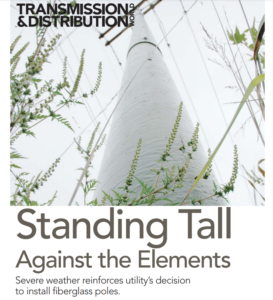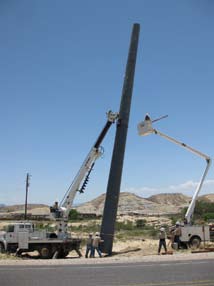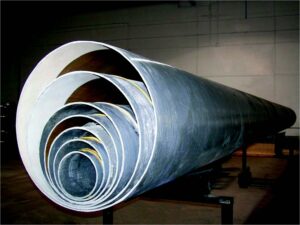
Composite Poles Support the “Circuit of the Future”
A Southern California Edison Analysis indicates the new pole materials provide lower total owning costs on its distribution system. By Mike Rodin, Southern California Edison Southern California is known for its beautiful weather. What is less generally known is how downright inhospitable the California environment can be to an electric utility’s infrastructure. Nowhere is this more evident than in the case of the ubiquitous utility pole. As every transmission and distribution engineer knows, pole installation and maintenance represent a major cost factor for utilities. The effects of weathering, termites, rusting, high winds and fires take a toll on utility support infrastructure every year, which of course drives up maintenance costs, increases circuit interruptions and reduces overall system reliability. If a way could be found to mitigate these problems effectively, maintenance costs could be lowered and overall grid reliability improved.` This modular composite pole is installed in San Bernardino, California, on the “Circuit of the Future”. (Photo by Kevin Coates.) Significant advancements have been made in the design and manufacture of transmission and distribution poles using new high-strength fiberglass fibers and polyurethane resins. Working with several composite pole manufacturers, Southern California Edison (SCE; Rosemead, California, U.S.) has been deploying various types of composite poles to specific locations in its service area to evaluate their performance. SCE recognizes that composite poles manufactured with the new materials hold promise for dramatically reducing pole life-cycle maintenance and the need for frequent pole replacements, even for reasons other than age. These improvements also hold promise for reducing the initial cost of setting a pole as well as reducing the need for pole replacements. FIRST THERE WAS WOOD The first electric utility poles used to support telegraph lines in the 19th century were from old forests. These trees were typically very dense and resilient hard woods. Today’s rapid-growth tree farms produce poles that are, of course, still wood. However, there is some degradation in the properties of rapid-growth poles: reduced durability, stiffness, and longevity. This means the new poles are less robust and do not resist insect infestation or wood rot as well and, therefore, have a shorter service life. These composite poles are framed with composite crossarms ready for helicopter transport to the mountainous installation location. These composite poles are framed with composite crossarms ready for helicopter transport to the mountainous installation location. To enhance pole longevity, today’s wood poles are treated with chemicals, such as Pentachlorophenol, suspended in a light oil as the vehicle or carrier to deliver the chemical treatment. This eventually presents utilities with a handling and disposal challenge when the poles reach the end of their service life, because the treated wood poles may fail hazardous-waste criteria. When treated wood is deemed hazardous, it cannot be abandoned in the field; it must be disposed of in specially permitted landfills. This practice increases ownership expense. Over time, it is likely that these disposal restrictions will become stricter. However, aside from wood rot or wood-boring insects, wood poles have a vulnerability that is especially problematic in California — they burn. This is where composite poles have a distinct advantage, as they are fire resistant and will not support combustion without the addition of an external heat source. COMPOSITE CHARACTERISTICS While not fireproof, composite poles are extremely fire resistant, particularly when coated with fire retardant. A propane flame can cause a composite pole to smolder with a limited amount of flame when applied directly to the surface of the pole; however, as soon as the flame is removed, the composite material ceases to smolder or produce flame. This makes composite poles extremely attractive for deployment in steep mountain canyons and ravines where wildfires may roll through an area in 20 to 30 minutes. In these locations, use of selected fire-retardant coatings can enable the poles to withstand up to two brush fires. More importantly, after exposure to fast-moving brush fires, the poles generally do not require replacement and will continue to support the lines and equipment with no loss of strength. Even fully assembled, the composite pole is substantially lighter than wood or other materials and easily transported by a helicopter. The resilience of composites is one of their more remarkable features. Composites allow strength parameters to be accurately “dialed in” during manufacturing to meet the job specification. This saves time and money and eliminates waste. The service life of a composite pole is conservatively rated at approximately 70 years on average. In addition, composite poles are extremely lightweight and strong, and do not lose their strength over their lifetime. Some composite poles, such as those from Resin Systems Inc. (Calgary, Alberta, Canada), are manufactured and shipped as modular sections (typically, 15-ft. [4.5-m] lengths are nested one inside the other), which reduces transportation and installation costs. For example, two men can easily lift. an individual 15-ft. module of a pole and maneuver it into position without any heavy equipment. This ease of handling also applies to the crossarms, which are typically very heavy work for linemen. EMBRACING CHANGE Obviously, any new product or technology offered to the electric power industry needs to be thoroughly tested before it can be deployed to a live grid. To better evaluate new technologies that might enhance grid reliability and possibly lower service costs, SCE created a new section on the grid in the Inland Empire Region known as the “Circuit of the Future.” SCE worked closely with a number of composite pole manufacturers, including Powertrusion International (Tucson, Arizona, U.S.) and Resin Systems, to help them design and manufacture a series of composite poles that meet SCE’s needs in terms of strength, durability, serviceability and service life. Each composite pole company has its own patented method of production, which means each type of pole has a unique set of characteristics. For instance, the Powertrusion pole is a non-tapered (i.e. it has a constant diameter) pultruded pole, while the Resin Systems pole is manufactured by winding E-Glass and polyurethane resin along with other proprietary materials onto a






